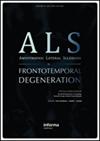Proteomic profiling of the spinal cord in ALS: decreased ATP5D levels suggest synaptic dysfunction in ALS pathogenesis
IF 2.8
4区 医学
Q2 CLINICAL NEUROLOGY
Amyotrophic Lateral Sclerosis and Frontotemporal Degeneration
Pub Date : 2017-04-03
DOI:10.1080/21678421.2016.1245757
引用次数: 17
Abstract
Abstract Background: We aimed to gain new insights into the pathogenesis of sporadic ALS (sALS) through a comprehensive proteomic analysis. Methods: Protein profiles of the anterior and posterior horn in post-mortem spinal cord samples of 10 ALS patients and 10 controls were analysed using 2D-differential gel electrophoresis. The identified protein spots with statistically significant level changes and a spot ratio >2.0 were analysed by LC-MS/MS. Results: In the posterior horn only 3 proteins were differentially expressed. In the anterior horn, 16 proteins with increased levels and 2 proteins with decreased levels were identified in ALS compared to controls. The identified proteins were involved in mitochondrial metabolism, calcium homeostasis, protein metabolism, glutathione homeostasis, protein transport and snRNP assembly. The two proteins with decreased levels, ATP5D and calmodulin, were validated by Western blot and immunostaining. Immunohistochemical and immunofluorescent double staining of ATP5D and synaptophysin showed that the reduction of ATP5D was most pronounced at synapses. Conclusions: We speculate that mitochondrial dysfunction in synaptic clefts could play an important role in sALS pathogenesis. A similar approach revealed decreased calmodulin expression mainly in the neuronal body and dendrites of ALS patients. These findings contribute to a deeper understanding of the disease process underlying ALS.ALS脊髓的蛋白质组学分析:ATP5D水平降低提示ALS发病机制中的突触功能障碍
摘要背景:我们旨在通过全面的蛋白质组学分析,对散发性ALS(sALS)的发病机制获得新的见解。方法:应用2D差分凝胶电泳分析10例ALS患者和10例对照者死后脊髓前角和后角的蛋白质谱。通过LC-MS/MS分析具有统计学显著水平变化且斑点比率>2.0的已鉴定蛋白质斑点。结果:在后角,只有3种蛋白质有差异表达。在前角,与对照组相比,ALS中鉴定出16种水平升高的蛋白质和2种水平降低的蛋白质。所鉴定的蛋白质参与线粒体代谢、钙稳态、蛋白质代谢、谷胱甘肽稳态、蛋白质转运和snRNP组装。通过蛋白质印迹和免疫染色验证了ATP5D和钙调蛋白这两种水平降低的蛋白质。ATP5D和突触素的免疫组织化学和免疫荧光双染色显示,ATP5D的减少在突触处最为明显。结论:我们推测突触间隙中的线粒体功能障碍可能在sALS的发病机制中发挥重要作用。类似的方法显示,钙调素的表达减少,主要发生在ALS患者的神经元体和树突中。这些发现有助于更深入地了解ALS的发病过程。
本文章由计算机程序翻译,如有差异,请以英文原文为准。
求助全文
约1分钟内获得全文
求助全文
来源期刊

Amyotrophic Lateral Sclerosis and Frontotemporal Degeneration
CLINICAL NEUROLOGY-
CiteScore
5.40
自引率
10.70%
发文量
64
期刊介绍:
Amyotrophic Lateral Sclerosis and Frontotemporal Degeneration is an exciting new initiative. It represents a timely expansion of the journal Amyotrophic Lateral Sclerosis in response to the clinical, imaging pathological and genetic overlap between ALS and frontotemporal dementia. The expanded journal provides outstanding coverage of research in a wide range of issues related to motor neuron diseases, especially ALS (Lou Gehrig’s disease) and cognitive decline associated with frontotemporal degeneration. The journal also covers related disorders of the neuroaxis when relevant to these core conditions.
 求助内容:
求助内容: 应助结果提醒方式:
应助结果提醒方式:


